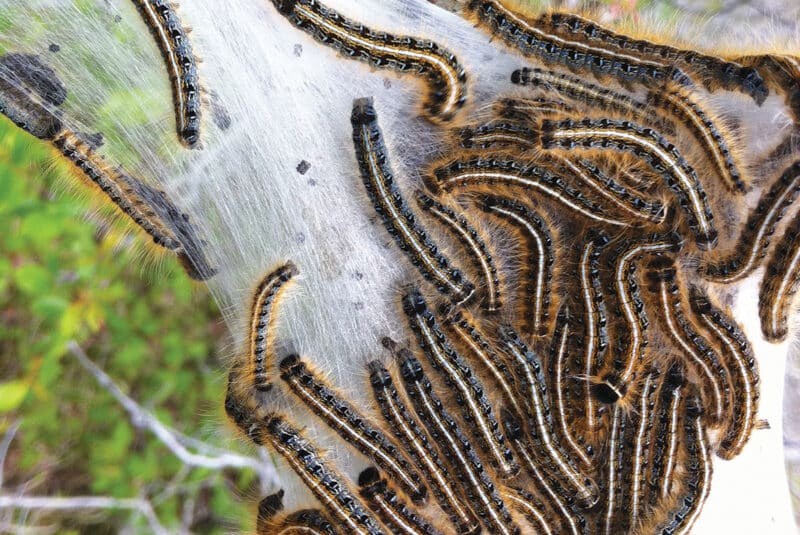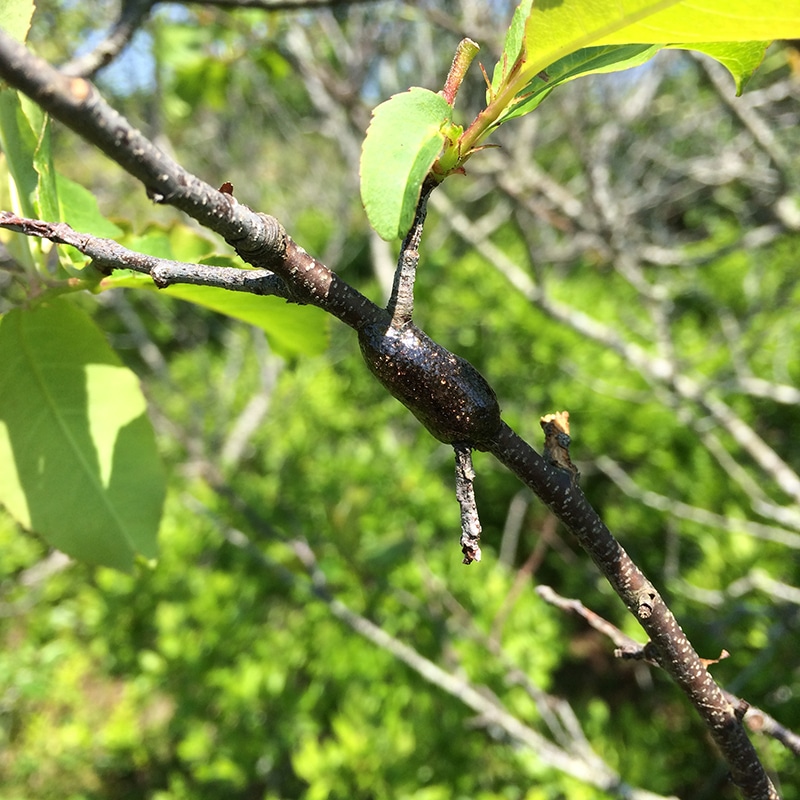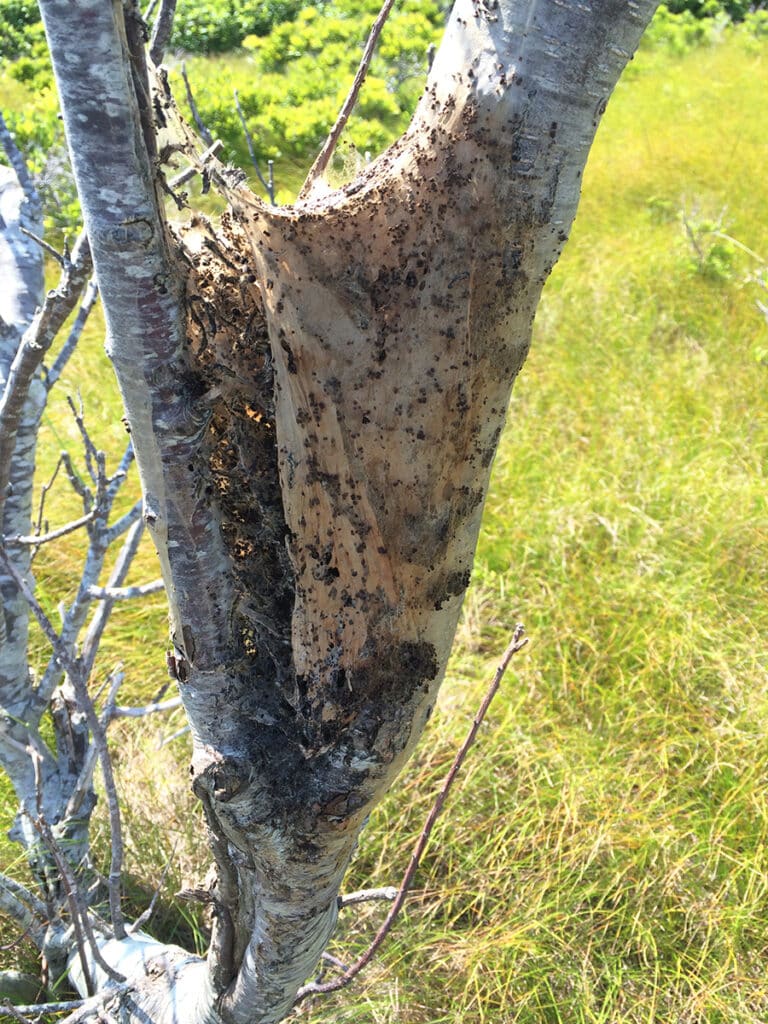by Dr. Sarah Treanor Bois, PhD
Director of Research & Education at the Linda Loring Nature Foundation
Spring seems to have finally arrived on the island. The Spring Equinox on March 19 officially marked the start of spring, but we all know not to be suckered in by those arbitrary dates. Traditionally, spring is marked more by the indicators of the changing season. It could be the Daffodil Festival which holds to the calendar date of the last weekend of April. Or it could be something more attuned to the spring climate: blooming forsythia, calling of spring peepers, and migratory birds arriving from their winter stays.
Do you have a favorite sign of spring?
One of my favorite indicators of spring temperatures is the hatch of a familiar insect: the Eastern Tent Caterpillar. This native creature is unique, and I hope to shed some light on an often-maligned species that I think deserves a little respect. Eastern Tent Caterpillars (or ETC) are hairy caterpillars, black with a white stripe down the back, brown and yellow lines along the sides, and a row of oval blue spots on the sides. And they are true harbingers of spring. Instead of being restricted by a calendar date or light cues, the ETC are very sensitive to temperature and hatch out of eggs after several successive days of spring like temperatures.
Because of this sensitivity to early warm temperatures, ETC have been used as indicators of spring and studied to track earlier warming. As we have seen with climate change effects in our region, warmer spring temperatures arriving earlier in the calendar year mean that ETC are hatching earlier than previous long-term averages. At the Linda Loring Nature Foundation, we have been recording ETC hatch date at the LLNF property since 2015. We don’t have enough data yet to note a seasonal shift, but in the last nine years we have seen the hatch date vary annually between April 24 and May 6. As of this writing (April 21), there still aren’t any caterpillars to be found, but my guess is any day now!
Eastern tent caterpillars (Malacosoma americanum) are native to Nantucket and sometimes get a bad rap because they are confused with the invasive Spongy Moth caterpillar. Our native ETC, however, feed primarily on black cherry trees (Prunus serotina) and rarely kill a tree. As a spring species, ETC prefer young fresh leaves. In fact, the timing of ETC hatch has evolved to match the spring leaf-out of its host plant, though warmer, earlier springtime temperatures may be altering this relationship. ETC are quick to respond to warmer temps by hatching earlier, tracking the warm spring. Black cherries, on the other hand, have been shown to be slower to respond to early springtime temperatures and may not have enough leaves available for the young, hungry caterpillars to feast upon.
More research over time will help us learn more about this relationship and whether an ecological mis-match could affect ETC populations here on Nantucket or elsewhere across their range.
ETC actually spend a majority of their life (almost 75%) as an egg. The eggs that are readying to hatch this spring were actually laid by their parent last July! The tough egg masses contain about 150-200 small, white eggs which are covered with a shiny, black varnish-like material encircling small branches. The egg mass lasts through wind, rain, snow, sleet, hurricanes—you name it. As warmer temperatures arrive in March and April, the black coating begins to disintegrate like old insulation, leaving the eggs more exposed.
After hatching, the tiny black caterpillars will all huddle together on a branch to keep warm and absorb sunlight.
Many of us know that spring in New England, and certainly on Nantucket, is highly variable. One day you’re wearing short sleeves and basking in the sunshine and the next you’re pulling your parka back out and turning on the heat. This is where the genius of the tent caterpillar engineering comes in. Since they hatch out so early in the season, they are also susceptible to these temperature swings. Huddling together with your brothers and sisters only keeps you so warm. From the first few days of hatching, the caterpillars work together to build a silken tent with thread they produce. These “tents” are made with innumerable silken strands, usually in the crotches of branches in their host trees. The silken strands make many layers within the tent, which gets bigger as the caterpillars continue to add layers. During any cold, hot, rainy, or otherwise unfavorable weather conditions, the caterpillars retreat into the tent. They can thermoregulate by going deeper into the tent or hanging out near the surface layers.
They are such social creatures. Research has shown that caterpillars from two or more egg masses may unite to form one large colony. They do this even if the egg masses are unrelated. In addition to the tent construction and communal living, they help each other find food. Using pheromones and silken threads, the ETC will leave a trail to the fresh young leaves. When that resource is depleted, the silk is snipped off to break the route, and a new path is created.
As the ETC feed on foliage, they increase the size of the tent or web until it is a foot or more in length. In 4 to 6 weeks, the caterpillars are full grown and 2 to 2-1/2 inches long. At this point, the caterpillars will wander off solo to pupate in a cocoon. We usually find them in the leaf litter on the ground in a small silken cocoon where they remain for 3-4 weeks, emerging as an adult moth sometime in July. The adult moth is small, reddish-brown with two pale stripes running diagonally across each forewing. Moths are only around for about 5 days. In that time they mate, and females will lay eggs on small branches of our native black cherry trees. They usually lay the eggs closer to the ends of branches where the future hatchlings will be more likely to find fresh leaves to eat. And the cycle begins again with this generation of eggs lying in wait from July until the next spring when warm temperatures again signal for them to emerge.
Since the ETC on Nantucket haven’t hatched yet, we don’t know for sure if 2024 will be a boom or bust year for the caterpillars. The last big boom year, with caterpillars found in large amounts across the island feasting on all manner of species, was in 2015. The boom and bust cycles last about 10 years, so we are close to “due” for another boom if climatic conditions cooperate. Based on the number of egg masses I’ve seen on the black cherry trees at the Linda Loring Nature Foundation property, I think we are in an upswing with 2025 or 2026 as the next big year. A boom year for caterpillars also means a caterpillar buffet for many species of birds who readily eat the ETC. And the caterpillar frass (aka poop) also serves to fertilize surrounding vegetation.
Hopefully now, instead of spraying them with insecticide or otherwise cursing them, we can all appreciate these ecosystem engineers! Eastern tent caterpillars are a true sign of our Nantucket spring. Keep an eye out for the Linda Loring Nature Foundation social media to learn when our ETC eggs hatch for 2024.





